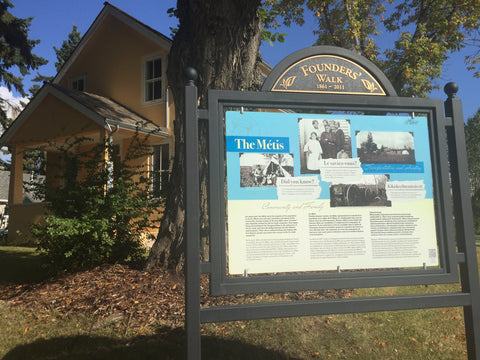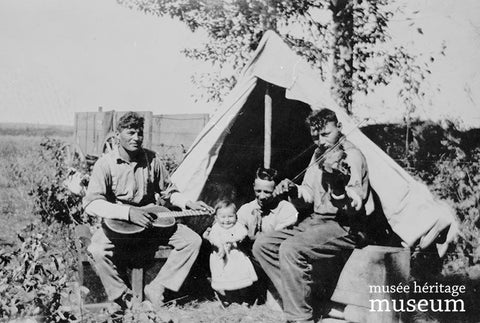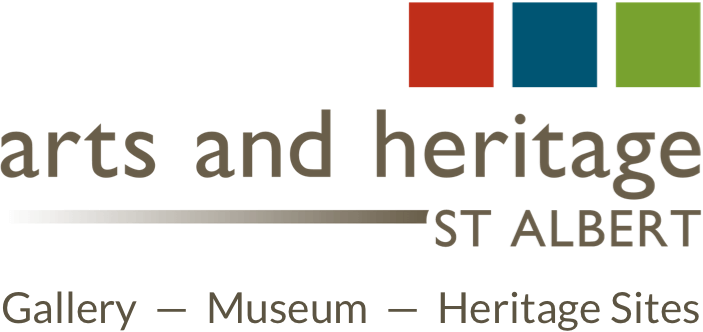

ONLINE EXHIBITION
9. The Métis
The Métis
For many years the Métis were the majority of the population in the St. Albert area and were involved in all aspects of the community. A large number of the local Métis were “freemen” who originally worked for the fur trade companies. They began living and working in the Sturgeon Valley in the early years of the fur trade and were the bridge between the First Nations and Europeans. Their role in communicating and trading with First Nations groups was vital to the success of the fur trade companies.
By the early 1800s, the Northwest Company began keeping its horses around Big Lake and the Métis, who cared for the herds, became well known for their skill in working with horses. In 1861, many Métis from Lac Ste. Anne came to the new community of St. Albert where they laboured hand-in-hand with local Métis, Oblates and Grey Nuns to build the Mission and develop the community. The Métis of St. Albert are descended primarily from marriages between French – and English-speaking fur traders and women of Algonquin, Cree and Ojibwa origins.
Les Métis
Pendant plusieurs années, les Métis représentaient la majorité de la population de la région de St-Albert. Ils s’impliquaient dans tous les aspects de la vie communautaire. Plusieurs Métis locaux étaient des hommes libres qui travaillaient à l’origine pour les compagnies de fourrures. Ils ont commencé à vivre et à travailler dans la vallée de l’Esturgeon durant les premières années du commerce des fourrures. Leur rôle était vital, non seulement au succès des compagnies de fourrures, mais aussi comme traducteurs entre les Premières Nations et les Européens.
Au début du XIXème siècle, la Compagnie du Nord-Ouest commença à garder ses chevaux autour de Big Lake et les Métis qui prenaient soin des troupeaux ont vu grandir leur réputation d’habiles palefreniers. En 1861, plusieurs Métis qui habitaient au Lac Ste-Anne ont déménagé dans la nouvelle communauté de St-Albert. Avec les Oblats, les Soeurs Grises et les Métis déjà installés, ils ont aidé au développement de la Mission et de la communauté. Les Métis de la région de St-Albert sont majoritairement les descendants des employés de langue française ou anglaise des compagnies de fourrures, qui ont épousé des femmes d’origine Algonkienne, Crise ou Ojibwa.
Otipeyimisiwak
Mihcetwaskiy Otipeyimisowak kîmâmawacimihcetiwak ewîkîstahkik St. Albert ekota emâmawistahkik pikokîkway ketâhkamikahk ekikipayicik sîhcikewinihk. Mihcet Otipeyimisowak kîhatoskâtamwak nôcîcikewin ekwa tâpakwewin ehatâwâkecik okâhcitewinkewâwa. Mistahi kîtasîhkamwak môswekinwa ekwa amiskwayâna, ehatoskawâcik mônîyâw osîhcikewa ekwa okimâw meskotônikewa. ekîwihkîstahkik ekwa ehatoskecik papâmi Sturgeon Valley ekîhitwestamâkecik isîhcikewinihk. Kîmisiwîcihtâsowak enakiskamotahâcik mônîyâwa ekwa nehiyawa ekwa mîna kotaka iyiniwa, tamiyowîcihtoyit.
Nânitaw 1800,Northwest Company kîmâcikanaweyimewak otemiwâwa kîwihkewinewak anita Big Lake (Misti sîpiy)ekwa ôki Otipeyimisowak kînistaweyihtâkosiwak enihtâmohkwâwikanestimwecik eyospisîhâcik mistatimwa. Ispî ekwa 1861 kîmâcipiciwak Otipeyimisowak Lac Ste. Ann ohci epetawayitocik St. Albertinâhk epewîcihatoskemâcik kotaka Otipeyimisowa âsay ekota ewîkiyit, ayamihewiyiniwa, ayamihewiskwewa tamiyomamawîkicik. Otipeyimisowak, St Albert ohci kîpeyihtakowak owîkihtowinihk ohci wemistikosiwak, âkayâsowak enakiskawâcik nehiyawiskwewa, Algonquin ekwa Ojibwa iskwewak.




